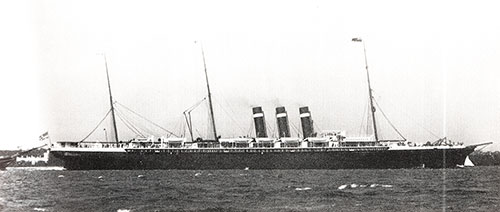Steamship Crews on the SS City of New York - 1903

The SS City of New York (1888) of the Inman Line, shown aboe as the SS New York of the American Line circa 1893. GGA Image ID # 146ec0921b
The Atlantic steamship City of New York is commanded by Capt. Frederick Watkins, and his right hand man, the chief officer, Is S. F. Barif. To help these two to navigate the ship six deck officers are provided, and three of them are constantly on deck when at sea.
In addition to these, In what may be called the department of seamen, there is a boatswain and his mate and 36 sailors, of whom 12 men are called quartermasters, who are detailed to steer the ship and stand on lookout.
Mr. McLeod, the chief steward, Is assisted by Mr. Findlow, formerly steward of Jay Gould's y yacht Atalanta, and by 146 other people, of whom seven are women and eight are boys in their teens, called bell boys.
Mrs. Nichol is the chief stewardess, and four women help her In the first cabin. The second cabin and the steerage have one stewardess each. Of the other people In this department 36 are table waiters, 16 are bedroom stewards and attend to keeping staterooms in order, to are occupied in the pantry, 16 are cooks, 6 are porters, 5 are messroom stewards and wait on the officers, 14 are in the second cabin, 16 are in the steel age, 4 are bakers, three are butchers, and 5 are storekeepers, and this term Includes the bartenders and the men in immediate charge of the rooms where provisions, etc., are kept.
There is also a ship's carpenter, who is generally as handy aloft as with the saw and adze. In charge of the machinery are a chief engineer, Mr. McDaugail, and 27 assistant engineers, besides 1 electricians and their 3 assistants, who look after the electric lights; 3 donkey men, 31 leading firemen, 54 firemen, 63 trimmers, and
one blacksmith.
The donkey men are foremen in charge of the boilers; the leading firemen are also called greasers, and it is their duty to keep the machinery oiled and cleaned. The 54 firemen shovel coal Into the furnaces and se that it Is spread just right to burn as hot as possible, and when the furnace nerds cleaning they do the work. The trimmers shovel the coal from the bunkers into the stoke hole.
While this completes the list of the three great departments into which a ship's company is divided, there is yet a purser. who is a keeper of accounts, besides having a lot of other important duties to attend to, and the ship's surgeon, who has one assistant.
The number of stewards carried varies with the passenger traffic. The total number of crew of the City of New York when she sailed was, according to the purser, 394.
Few persons are aware of the extensive nature of the victualling on board the great ocean steamers. Each vessel is provisioned as follows for the round voyage for passengers and crew:
- 3,500 lbs. of butter,
- 3,000 hams,
- 1,600 lbs. of biscuits, exclusive of those supplied for the crew;
- 8,000 lbs. of grapes, almonds, figs, and other dessert fruits;
- 1,500 lbs. of jams and jellies;
- tinned meats, 6,000 lbs.;
- dried beans, 3,000 lbs.;
- rice, 3,000 lbs.;
- onions, 5,000 lbs.;
- potatoes, 40 tons;
- flour, 300 barrels; and
- eggs, 1,200 dozen.
Fresh vegetables, dead meat and the buttocks, sheep, pigs, geese, turkeys, ducks, fowls, fish, and casual game are generally supplied at each port, so that it is difficult to estimate them. Probably two dozen bullocks and 60 sheep would be a fair average for the whole voyage, and the rest may be inferred in proportion.
During the summer months, when travelling is heavy, 25 fowls are often used in soup for a single dinner.
The bar on an ocean vessel Is one of the most profitable features of the slip, and it has been said that $5,000 has frequently been cleared on one voyage by a first class steamer In the busy season.
The possibilities in this direction may be judged from the fact that the Etruria puts on board at Liverpool for the round voyage 1,100 bottles of champagne, 850 bottles of claret, 6,000 bottles of ale; 2,500 bottles of porter, 4,500 bottles of mineral water and 650 bottles of various spirits, while the annual consumption of the Cunard Line is as follows: 8,030 quarts and 17,613 pints of champagne, 13,941 quarts and 7,310 pints of claret, with 9,200 bottles of other wines, 489,344 bottles of ale and porter, 174,921 bottles of mineral waters, 34,000 bottles of spirits, 34,360 pounds of tobacco, 63,340 cigars and 56,875 cigarettes.
Whitehead, Jessup, The Steward's Handbook, Chicago (1903) Pages 160-161
